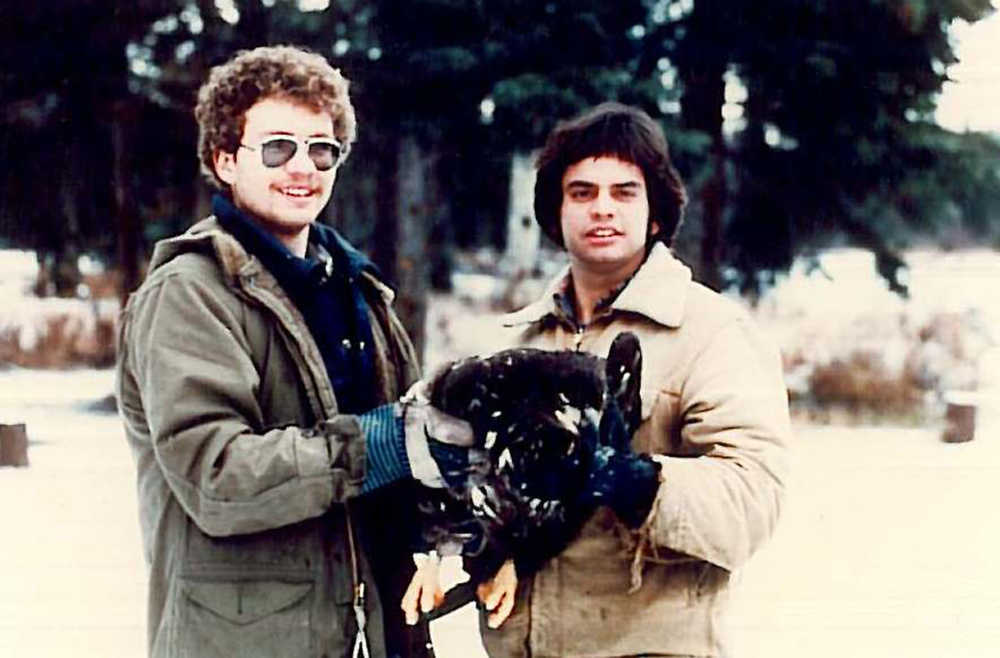On a frosty morning in February 1985, biologists from the Kenai National Wildlife Refuge hunkered down in the bushes waiting for takers on their carefully laid trap. On a mostly unfrozen section of the Kenai River, a salmon carcass was strategically placed at the waterline and a padded foothold trap was submersed in the adjacent water. As the trap grabbed an adult Bald Eagle by the foot, the biologists sprinted into action. The eagle was secured, banded on one leg and fitted with a small backpack- mounted radio transmitter. After being released, the perturbed eagle flew to a nearby cottonwood and examined its newly installed bracelet.
For the record, this large adult female eagle would now be known only by its radio frequency #166.590. A total of 13 eagles were fitted with transmitters using this technique in 1985. For the remainder of the winter and throughout the summer they were periodically tracked to see where they went and if they nested on the Kenai Peninsula.
Eagle 166.590 was a bit elusive. After capture she immediately disappeared. In March, she relocated to a strip of woods in Halibut Cove on the south side of Kachemak Bay. She disappeared again and was discovered in May along the Swanson River. From that point on, she was never heard from again until just recently.
Biologists from Alaska Maritime National Wildlife Refuge responded to a report of an eagle that had been electrocuted in a collision with powerlines near Homer. Upon retrieving the dead eagle, they discovered an aluminum band on its leg. After reporting the band number to the Bird Banding Lab (www.reportband.gov) we were all notified that this eagle had been banded almost 29 years ago!
The backpack was long gone as they are designed to disintegrate after a couple of years. Other than the obvious damage from the collision with the powerline, the bird appeared to have been relatively healthy and in good body condition for its age.
If you factor in the age of the bird when it was banded, this eagle was a minimum of 33 years and 8 months old at the time it died, making it one of the oldest known wild Bald Eagles ever banded. We have to indicate wild, because there is a report of a captive eagle in New York that lived to 50 years old! It shows that even when you are at the top of the food chain, the stresses of the natural environment can be costly.
While “our” 33 year old Bald Eagle from the Kenai Peninsula is impressive, nothing can rival the iconic star of the elderly bird world like Wisdom the Laysan Albatross. This impressive record setter just hatched what is believed to be her 35th chick at the ripe young age of 63 years old. In her lifetime she has likely logged more than 3 million flying miles around the Pacific Ocean between Hawaii, Japan and Alaska.
After gallivanting around the Pacific, Wisdom periodically stops at Midway Atoll National Wildlife Refuge to nest and rear a single chick. This nesting process may take up to half a year. Surviving countless cyclones, typhoons and tsunamis, Wisdom is the oldest wild banded bird on record in the U.S. and she is still going strong.
One common attribute of long lived bird species is that they usually take a long time to mature before entering the breeding force. Laysan Albatrosses often fly around for 7 or 8 years before making their first breeding attempt. Bald Eagles will usually be in their 6th calendar year before first nesting and, in most cases, these early attempts are failures. Who would have guessed that Bald Eagles on the Kenai may take longer than a brown bear to mature and enter into the breeding population?
Longevity and delayed maturity are difficult factors in studying some birds and also pose problems when trying to assess population levels or recovery efforts. At any point in time, there is the breeding or nesting portion of the population and the non-breeding portion that may not be coming back to nest for several years. Also, if an action is taken to help a struggling population, it may take several years before a response can be measured. If that effort was unsuccessful, it may take years before we actually know that a different approach is needed.
One thing is certain. In 1985 I was in high school. The last thing I was thinking about was banding Bald Eagles. I am thankful that biologists at the time were banding these birds as it gave me the unique opportunity to see one of the oldest banded Bald Eagles ever. It also revitalized me in knowing some of the work I do is for the here and now, but some will be fruit on someone else’s tree long after I leave the Kenai National Wildlife Refuge.
Todd Eskelin is a biologist at the Kenai National Wildlife Refuge. He specializes in birds and has conducted research on songbirds in many areas of the state. You can find more information at http://kenai.fws.gov or http://www.facebook.com/kenainationalwildliferefuge.

